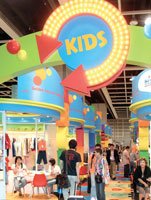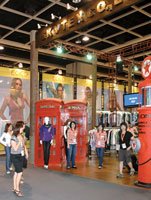Higher Prices a Sign of the Times at Hong Kong Fashion Week
HONG KONG—The beginning of 2009 marks the end of U.S. quotas on all Chinese apparel, which means that American buyers should have been flooding Hong Kong Fashion Week to survey the 1,153 companies that had booths at the biannual trade show.
But with daily bursts of down-in-the-dumps economic news coming out of Washington, D.C., American buyers perusing the packed aisles inside the Hong Kong Convention Centre were wringing their hands. Overseas attendance inched up only 0.8 percent to 7,273 buyers. Total attendance, which included Hong Kong visitors, increased 2.9 percent to 10,151 people.
“Business is terrible. It’s not good,” lamented Dany Separzadeh, owner of Fantazia Inc., a blouse manufacturer and wholesaler located in the heart of the Los Angeles Fashion District. His business is down 25 percent from last year, and he doesn’t believe he has reached the bottom yet. “Nobody is calling. Your hands are tied,” he noted.
Separzadeh has been attending Hong Kong Fashion Week for the past five years. At this year’s July 8–11 show, he noticed a definite surge in prices coming from Chinese manufacturers, who cite rising factory wages and a depreciating U.S. dollar as reasons for the increase. “Prices have gone up like crazy,” the Los Angeles businessman said.
Blouses that were wholesaling last year for $15 now cost $20. “Manufacturers are saying that gas prices have gone up as well as the [Chinese yuan] exchange rate. The old factories I have worked with for years are more reasonable, but the new ones seem to be trying to raise prices.”
Hong Kong’s apparel industry has been deeply affected by the U.S. economi c downturn. Last year, Hong Kong exported $28.8 billion in clothing and accessories to the United States, a 1.8 percent increase. But exports to the United States, Hong Kong’s No. 1 market, were down 11.4 percent, to $2.59 billion, during the first four months of this year. The United States makes up about one-third of Hong Kong’s apparel-related exports.
“The sluggish U.S. economy has inevitably affected our industry,” said Vincent Fang, chairman of the Hong Kong Trade Development Council’s garment advisory committee. “But Hong Kong garment companies are experienced, resilient and blessed with the flexibility to respond to changing market conditions.”
He pointed out that sales have jumped by at least 20 percent this year to markets in Russia, Malaysia, Turkey, Indonesia, Argentina and the Czech Republic.
That being said, Hong Kong’s total exports of apparel-related goods still slipped 3 percent, to $7.7 billion, during the first four months of this year.
Uneasy times
Exhibitors on the floor of the Spring/Summer 2009 show, which covered three vast halls, were experiencing a variety of mood swings. Some looked bored as they sat inside their booths, playing games on their cell phones or laptop computers. Others were busy talking to buyers.
The secret to success appeared to be uniqueness. Buyers were definitely hunting for that special item to lure customers into stores.
“Right now, the U.S. market is tough,” said Mary Vargas, owner of Tata Jolie, a 1-year-old company in Miami that sells to boutiques in Latin America and the United States. Currently, stores in Venezuela, Puerto Rico, Colombia, Ecuador and Chile make up 70 percent of her business.
She and her colleague Reyna Arias were on the prowl for designs with a difference. “We want to see new fashion,” Arias said.
New and exciting fashions were keeping Xu Shuang Quan busy. He is the owner of the 10-year-old Win-Light Textiles Co. in Hangzhou, China, a beautiful city dominated by an enormous lake and a 1,200-mile canal that connects to Beijing.
Several European buyers were crammed into his double-wide booth. One man was taking photos of various short cotton dresses whose bright hues of orange and pink were reminiscent of popsicles. At the other end, a French buyer fingered a pair of lavender cropped pants with cargo pockets. Color and youthful looks were working for the owner, who only attends Hong Kong Fashion Week.
Asked if this is a good show to attend, he shrugged and said: “It depends on your collection. If you have a good collection, it is quite good.”
His goods sell mostly in Europe, but he had a buyer from Southern California–based Max Studio, the contemporary label and retailer, drop by and take a serious interest in his line of youthful-looking clothing.
Also doing brisk business was Creative Clothing International Ltd., a Hong Kong company with three factories and a laundry located 45 minutes away in Shenzhen, China. Creative Clothing makes a wide array of blue jeans and T-shirts with a special twist.
Michael Hui, the company’s production and quota manager, said the company was constantly coming up with new innovations to move sales. For the Spring/Summer 2009 season, designers had developed different denim washes and fabrics that were proving popular among European buyers.
He pointed to a dark, shiny coated-cotton jean fabric that almost looked like leather. A collection of grayish-blue denim jeans with a beige interior and a wrinkled texture on the outside was particularly popular, wholesaling for $11. He said everyone was intrigued by a stretchy pant fabric that made the wearer look slimmer.
Anil Abuja, a textile engineer who owns Abuja Web Pvt Ltd., a women’s clothing company in India, was very happy that he had an order from China, his very first. A buyer bought 2,000 garments that wholesaled for no more than $14 each. “This fair always gives us some good business,” said Abuja, whose wife designs all the Indian-looking cotton and silk garments done in soft colors.
For every winner, there seemed to be a loser. Representatives from Charlie Koh Ltd., a Hong Kong company with a factory in Shenzhen, looked glum as they packed up their goods at the end of the show. Their elegant mother-of-the-bride suits didn’t sell well this year, said company representative Susan Su.
The only U.S. company to show at the fair was H. Concours, a high-end leatherwear company based in Malibu, Calif.
Helen Yu, the company’s president, is rather new to the apparel game. Her experience for the past 15 years has been in marketing. While working in Mexico City for Colgate-Palmolive, she met designer Joseacute; Saacute;nchez and fell in love with his soft Italian-leather jackets and dresses. Two years ago, she formed H. Concours to try to brand his creations, which are made in a San Diego factory that employs 20 people. “Our audience is very sophisticated and stylized,” she said.
The line’s wholesale prices reflected the target audience. Jackets go for $800 and coats are tagged at $1,000. Other pieces include leather shorts ($300) and tank tops ($320).
Yu visited the Hong Kong show two years ago and thought it would be a good place to garner some clients from Hong Kong and Japan. Currently, the company does a lot of direct sales to Colombia, Mexico and Brazil. “I think the traffic is quite low,” she said, sitting in a stylish booth where purple moireacute; fabric covered her table and hang racks. “I’ve gotten good feedback for the collection, but I expected more orders.”
Equally disappointed was Ted Budiana, marketing sales manager for Hangzhou Golden Season Fashion Co. Ltd., which has a showroom and warehouse in New York but manufactures in a Chinese factory with 1,000 workers. The company, which does business in the United States under the label Samuel Dong, is a regular attendee at the fair. They showed a collection of white as well as black-and-white blouses wholesaling for $29 to $69. “It is really not a good fair,” Budiana observed. “It was really slow this time. I think it was better last July.”
























